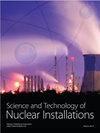Characterization of Waste Generated from Nuclide Management Process in Waste Burden Minimization Technology for Spent Nuclear Fuel
IF 1
4区 工程技术
Q3 NUCLEAR SCIENCE & TECHNOLOGY
引用次数: 2
Abstract
To reduce the environmental burden caused by the disposal of spent nuclear fuel, waste burden minimization technology is currently being developed at the Korea Atomic Energy Research Institute. The technology includes a nuclide management process that can maximize disposal efficiency by selectively separating and collecting major nuclides in spent nuclear fuel. To manufacture a waste form of high durability, the characteristics of the waste generated during the process should be evaluated. In this study, the physical, radiological, and thermal characteristics of the waste and waste forms for major nuclides (Cs, Sr, I, transuranic/rare earth, and Tc/Se) generated in the nuclide management process were analyzed. In the case of Cs nuclides, characterization was conducted according to the capture rate of the adsorbent in the high-temperature heat treatment process; meanwhile, in the case of Sr nuclides, characterization was performed by considering the ratio of similar nuclides in the chlorination process. For I nuclide, analysis was performed based on the available waste form, and for TRU/RE and Tc/Se nuclides, analysis was performed by considering chlorination and mid-temperature heat treatment. The radioactivity and heat generation rate of each waste and waste form were evaluated over a period of 1,000 years. The results of this study could be used to derive the centerline temperature for the thermal stability evaluation of waste forms and for the feasibility evaluation of each disposal system considered in the waste burden minimization technology.乏燃料减负技术中核素管理过程产生的废物特性
为了减少废核燃料处理造成的环境负担,韩国原子能研究所目前正在开发废物负担最小化技术。该技术包括一个核素管理过程,通过选择性地分离和收集乏核燃料中的主要核素,可以最大限度地提高处置效率。为了制造高耐久性的固化体,应评估该过程中产生的固化体的特性。在本研究中,分析了核素管理过程中产生的主要核素(Cs、Sr、I、超铀/稀土和Tc/Se)的废物和废物形式的物理、放射性和热特性。在Cs核素的情况下,根据吸附剂在高温热处理过程中的捕获率进行表征;同时,在Sr核素的情况下,通过考虑氯化过程中相似核素的比例来进行表征。对于I核素,根据可用的废物形态进行分析;对于TRU/RE和Tc/Se核素,通过考虑氯化和中温热处理进行分析。在1000年的时间里,对每种废物和固化体的放射性和发热率进行了评估。该研究的结果可用于推导中心线温度,用于评估固化体的热稳定性,并用于评估废物负荷最小化技术中考虑的每个处理系统的可行性。
本文章由计算机程序翻译,如有差异,请以英文原文为准。
求助全文
约1分钟内获得全文
求助全文
来源期刊

Science and Technology of Nuclear Installations
NUCLEAR SCIENCE & TECHNOLOGY-
CiteScore
2.30
自引率
9.10%
发文量
51
审稿时长
4-8 weeks
期刊介绍:
Science and Technology of Nuclear Installations is an international scientific journal that aims to make available knowledge on issues related to the nuclear industry and to promote development in the area of nuclear sciences and technologies. The endeavor associated with the establishment and the growth of the journal is expected to lend support to the renaissance of nuclear technology in the world and especially in those countries where nuclear programs have not yet been developed.
 求助内容:
求助内容: 应助结果提醒方式:
应助结果提醒方式:


